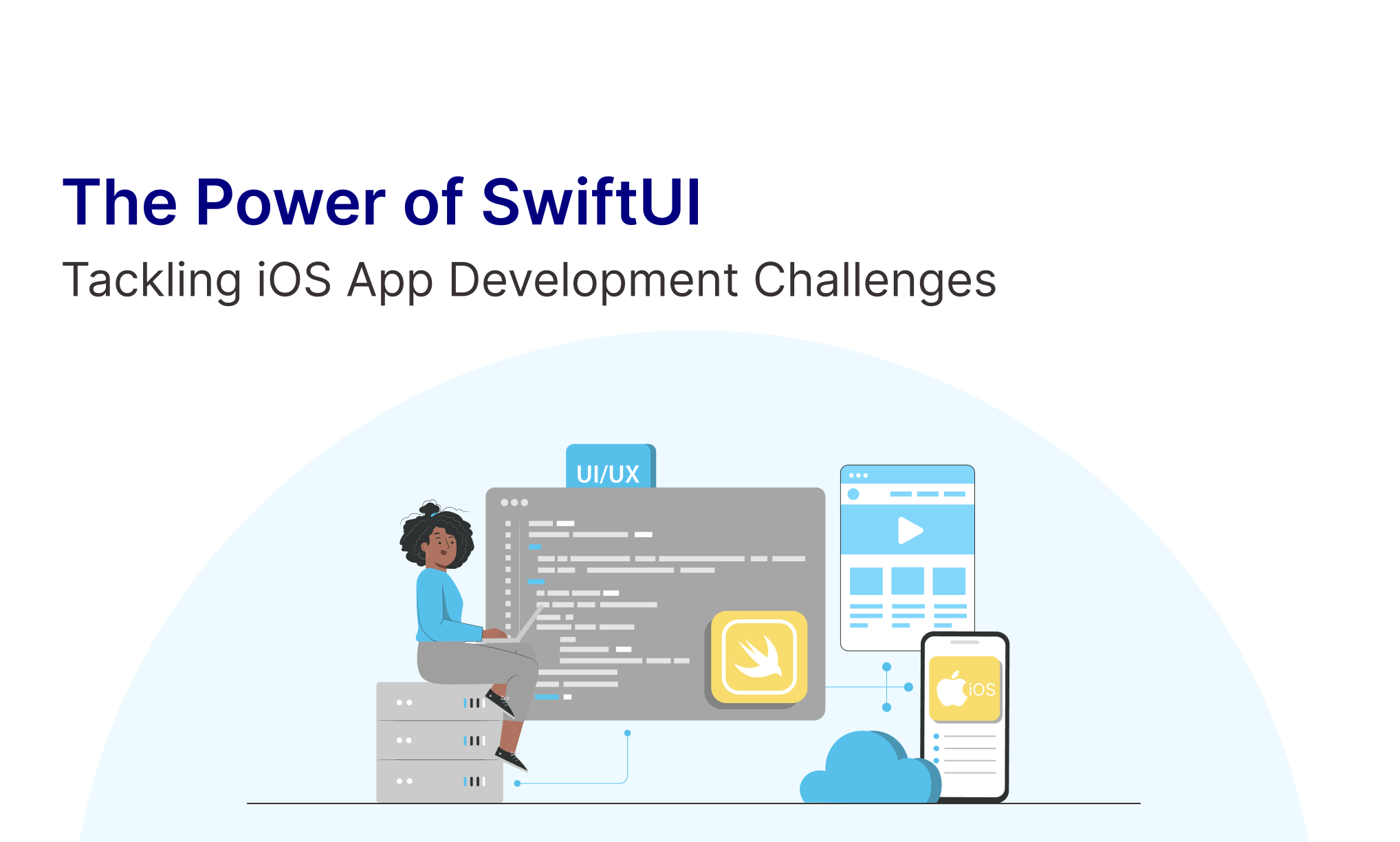Table of Contents
Developing iOS apps has long presented unique challenges for developers, from the steep learning curve of UIKit to the verbose code required to create even basic user interfaces. However, since its introduction in 2019, SwiftUI has fundamentally transformed how iOS apps are built. Designed with simplicity, flexibility, and elegance, SwiftUI addresses many longstanding pain points in iOS app development. In this blog, we’ll explore some of these challenges and how SwiftUI provides solutions that make creating iOS applications faster, more intuitive, and more accessible.
Traditional Challenges in iOS App Development
- Complex and Verbose Code in UIKit
- UIKit has been the backbone of iOS development since the beginning, but its complexity can often be overwhelming. Even relatively simple UI elements require numerous lines of code and extensive use of delegates and protocols.
- Example: Creating a table view requires setting up a data source, managing cells, and often involves multiple files and delegate methods to perform actions, making the code difficult to read and maintain.
- Limited Real-Time Feedback
- Traditional development requires running the app on a simulator or physical device to see UI changes, which can be time-consuming.
- The lack of a live preview means developers often go through a cycle of code changes, builds, and debugging before achieving the desired UI appearance.
- State Management Complexity
- Managing the state of the app is challenging in traditional iOS development. Developers need to carefully handle the states across different controllers and classes, leading to potential bugs and maintenance issues, especially as the app scales.
- Cross-Platform Inconsistencies
- Developing apps that look consistent across iOS, macOS, and other Apple platforms is challenging with UIKit. UIKit was not designed to work seamlessly with other Apple platforms, which can lead to significant rework when targeting different devices.
How SwiftUI Resolves These Challenges
- Declarative Syntax for Simplified UI Code
SwiftUI’s declarative syntax is a game-changer for iOS developers. In SwiftUI, you describe what the UI should look like rather than how to build it step-by-step, resulting in cleaner and more readable code.
- Example: Instead of writing code for each UI component’s setup in multiple methods, you can declare a view in a single, readable block of code. Here’s a comparison:
- UIKit:
let label = UILabel()
label.text = “Hello, World!”
label.textColor = .black
view.addSubview(label)
- SwiftUI:
Text(“Hello, World!”)
.foregroundColor(.black)
SwiftUI drastically reduces code redundancy and boilerplate, making it easier to read, write, and maintain.
2. Real-Time Preview and Hot Reloading
SwiftUI’s Xcode Preview feature enables real-time previews of UI changes, helping developers see their adjustments without compiling or running the entire app.
- Xcode Previews: By leveraging live previews, developers can make changes to their code and see the effects immediately. This feature helps save time and reduce the trial-and-error debugging that is common in UIKit-based projects.
3. Built-In State Management
SwiftUI provides native tools like @State, @Binding, and @ObservedObject to manage state across views, making data flow more intuitive and reducing the complexity of manually syncing data across components.
- State Management: SwiftUI components automatically re-render when data changes, keeping the UI synchronized with the underlying data model. This eliminates a lot of the boilerplate code needed to manage state transitions in UIKit and reduces the risk of inconsistent UI states.
4. Cross-Platform Support
SwiftUI is designed to work across all Apple platforms, including iOS, macOS, watchOS, and tvOS. This cross-platform capability allows developers to write code once and deploy it across multiple Apple devices, helping reduce development time and effort.
- Universal App Support: SwiftUI views and layout systems are designed with responsiveness in mind, which makes it easier to build adaptive UIs that adjust to different screen sizes and orientations.
Key Benefits of SwiftUI
- Faster Development Cycles
- SwiftUI’s declarative nature, combined with real-time previews, allows developers to iterate on UI quickly, leading to faster prototyping and fewer build times.
- Improved Readability and Maintainability
- SwiftUI’s declarative syntax significantly improves the readability of the code. This makes it easier for teams to collaborate, troubleshoot, and maintain the codebase as the project grows.
- Enhanced Performance
- SwiftUI is optimized to work with Swift, which means it is highly efficient and optimized for Apple hardware. The declarative syntax lets the SwiftUI framework handle a lot of optimizations in the background, freeing developers to focus on building the best possible user experience.
Final Thoughts
SwiftUI has revolutionized iOS app development, addressing several challenges that once bogged down developers. By providing a declarative syntax, real-time previews, intuitive state management, and seamless cross-platform compatibility, SwiftUI offers a modern approach to building powerful and visually engaging apps for the Apple ecosystem. While it is still evolving, SwiftUI has made iOS app development faster, more accessible, and more efficient.
With the continuous updates to SwiftUI, developers can expect even more features and tools to make iOS development easier and more enjoyable. So, if you’re considering building an iOS app, SwiftUI is definitely worth a try. It just might redefine how you think about app development.








